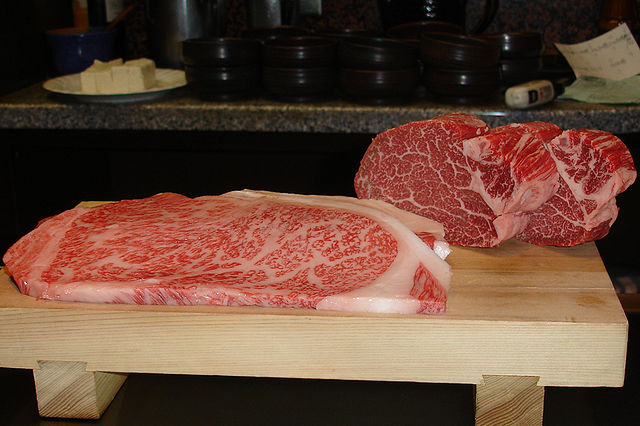What’s Your Beef?

Pictured above is a cut of Kobe beef, which if you’re a food aficionado at all (or, simply cognizant of that world), you have certainly heard of. Some of you may have gone out to dinner and even ordered it, paying a premium for this high-quality Japanese delicacy and entree du jour.
But, unless you ordered it in Japan, chances are you haven’t eaten it.
There are black cattle in Japan called Wagyu, whose meat is known for its exceptional taste. The meat has a larger than typical percentage of unsaturated fat, as evidenced by the marbling seen above, as well as containing more omega-3 and omega-6 fatty acids. Altogether, Wagyu meat is considered more tender and flavorful than most meat, which in turn allows its cultivators to demand higher prices.
Kobe beef comes from a breed of Wagyu cattle called Tajima, which are found only in Hyogo Prefecture (the red region on this map) in Japan. Tajima cattle have been in that area for centuries, perhaps dating back to the second century when they were brought into the region to help in the rice fields. Because of the mountainous terrain in the area, the cattle inbred, keeping the gene pool non-diverse and hyper-localized. And if beef is not from Tajima cattle, it’s not, officially, Kobe beef. In fact, even that is not enough. To be branded Kobe beef in Japan, there are several conditions that must be fulfilled, as mandated by the Kobe Beef Marketing and Distribution Promotion Association, as seen here. According to Forbes, the Association has certified only three thousand cattle as eligible to become Kobe beef.
And the official Kobe beef is almost never exported from Japan. The Association also mandates where the beef can be sent, and before 2012, it was not exported at all — and even now, it is only to Macau and Hong Kong. (To give an idea of how recently this change occurred, Hong Kong received its first shipment of Kobe beef in July.) Other areas have never received a shipment of true Kobe beef. In the case of the U.S., that’s partially due to the American government, which banned beef from Japan back in 2010 after a foot-and-mouth outbreak there.
So, again, unless your Kobe steak was eaten in Japan, it wasn’t an official Kobe steak. Instead, you’re eating a “Kobe-style” steak, one which (in the U.S., at least) is typically from a non-Tajima Wagyu cattle cross-bred with an Angus. But many of the cattle-raising techniques are kept the same. For example, the cattle’s diet is mostly grass, and, in the U.S. and U.K., the cattle are often fed beer, much like the ones in Japan often are.
Whether the “official” aspects matter is up for debate, of course, so far as taste is concerned. But in some jurisdictions, there’s no debate when it comes to labeling. In Florida, for example, the Department of Business and Professional Regulation has stated that using the term “Kobe beef,” without further clarifying the cattle’s lineage, is “misrepresentation.”
Bonus fact: Kobe beef isn’t the only food whose origin matters. Champagne also makes the list. In order for something to be properly called champagne, its grapes must be exclusively from the Champagne region in France. (Some jurisdictions allow for the term to be used to describe sparkling wine generally, but that is only true in a minority of places.)
From the Archives: Cola Enforcement Agency: You probably haven’t been eating Kobe beef. But you probably havebeen drinking an extract from the coca (as in “cocaine”) leaf. And it is perfectly legal.
Related: Do a search on Amazon for “Kobe beef” and a lot of stuff will pop up. You may notice that almost all of them also say “wagyu” in them, as a way to get around the incorrect labeling otherwise.

Leave a comment